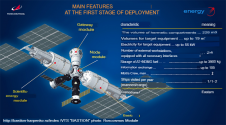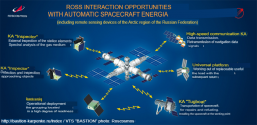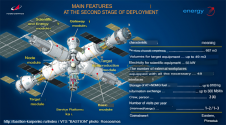You are using an out of date browser. It may not display this or other websites correctly.
You should upgrade or use an alternative browser.
You should upgrade or use an alternative browser.
NASA & World Space Exploration...News, Views, Photos & videos
- Thread starter bd popeye
- Start date
The first launch of the flight model is scheduled for 2027, said the Director General of the Center. M. V. Khrunichev Alexey Varochko
MOSCOW, 4 May. /TASS/. The assembly of the first flight model of the oxygen-hydrogen upper stage (KVTK) for the Angara will begin in 2025. This was announced in an interview with TASS by the Director General of the Center. M.V. Khrunichev (part of Roscosmos) Alexey Varochko.
"Given the production cycles, the production of the KVTK flight model is planned to begin after 2025," Varochko said.
The general director of the enterprise noted that the contract for KVTK has already been concluded, and design documentation is being prepared at the moment. From next year, the Center. M. V. Khrunicheva plans to start manufacturing a number of components for bench products in order to complete ground experimental testing by 2025. "The first launch, according to the plans that we currently have, is scheduled for 2027," Varochko stressed.
The general director of the enterprise also expressed the hope that this promising program would retain full funding so that the launch could be completed in 2027.



Roscosmos gears up for quantum communications experiment aboard orbital outpost
The space corporation is also planning under the Sfera project to carry out ‘Laser’ R&D work for laser data transmission, Director General Dmitry Rogozin revealed
MOSCOW, April 29. /TASS/. Russia’s State Space Corporation Roscosmos and the Russian Railways (RZD) railroad operator are set to conduct a joint experiment aboard the International Space Station (ISS) to test quantum communications, Roscosmos Chief Dmitry Rogozin told TASS on Friday.
"We will try to test technologies aboard the International Space Station that will allow us to get ahead of leading space powers. Together with RZD, we are planning to conduct one interesting experiment for quantum data transmission from board to board of the ISS and farther," Rogozin said.
The Roscosmos chief said he had held a meeting with RZD CEO Oleg Belozerov to agree on the start of this work.
"In addition, we are planning under the Sfera project approved by the government to carry out ‘Laser’ R&D work for laser data transmission," the Roscosmos chief explained.
Priorities
These tasks are useful and their results will be applied in creating a new Russian orbital cluster, the Roscosmos chief said.
"Today our priorities are to ensure the fulfillment of the defense procurement plan, replenish expendable materials used in the special military operation. Now all of our actions and thoughts are concentrated in this direction," Rogozin said.
The Yenisei methane rebuild.
Roscosmos set to implement super-heavy rocket project after 2030 — Rogozin
A heavy manned spacecraft that will undergo required flight development tests in low near-Earth orbit is needed to deliver the crew to the Moon
MOSCOW, April 29. /TASS/. Russia’s State Space Corporation Roscosmos is set to implement the project of creating a super-heavy carrier rocket for flights to the Moon after 2030, Roscosmos Chief Dmitry Rogozin told TASS on Friday.
"A super-heavy carrier rocket is needed to send a crew to the Moon. We have all the components for creating this super powerful spacecraft. We are planning to implement the project of the super-heavy launch vehicle within the framework that we earlier mentioned - after 2030," the Roscosmos chief said.
A heavy manned spacecraft that will undergo required flight development tests in low near-Earth orbit is needed to deliver the crew to the Moon, Rogozin explained.
"We can organize a manned mission to the Moon when we fully test the system of landing on and taking off from the Moon that will be based on the Luna-28 lunar mission technology," he elaborated.
The Roscosmos chief said in March last year that the Luna-28 inter-planetary automatic station intended to bring lunar soil (regolith) to Earth would be designed as a lunar take-off and landing vehicle.
Russian space chief to discuss cooperation on Moon with China by end of May
Last March, Dmitry Rogozin and head of the CNSA Zhang Kejian signed a memorandum of understanding and cooperation in the creation of the international lunar station
Roscosmos CEO Dmitry Rogozin Sergei Bobylev/TAS
Roscosmos CEO Dmitry Rogozin
 Sergei Bobylev/TAS
Sergei Bobylev/TAS
MOSCOW, April 29. /TASS/. Head of the State Space Corporation Roscosmos Dmitry Rogozin told TASS in an interview that he plans to discuss cooperation on the Moon with Chinese partners before the end of May.
"Before the end of May, I plan to hold detailed dialogue with our Chinese colleagues on our cooperation in this direction," he noted.
In November 2017, Roscosmos and China’s National Space Administration (CNSA) signed a space cooperation program for 2018-2022. It comprises six sections: the study of the Moon and deep space, space research and related technologies, satellites and their use, the components base and materials, interaction on data of Earth’s remote sensing and other issues. Working sub-groups were set up to implement projects under this program.
Last March, Rogozin and head of the CNSA Zhang Kejian signed a memorandum of understanding and cooperation in the creation of the international lunar station.
Moscow. 5 May. Interfax - Roskosmos has signed a contract with Rocket and Space Corporation (RKK) Energia for the development of a draft design of the Russian Orbital Service Station (ROSS) for 2.7 billion rubles, according to the public procurement portal.
The contract was signed between the state corporation Roscosmos and PJSC RSC Energia as part of the development work on the topic: "Creation of the space complex of the Russian orbital station".
According to the portal, the contract price is almost 2.7 billion rubles.
According to Roscosmos ", the preliminary design of the national station will be carried out in two stages.
"The first one involves the analysis of scenarios for the deployment and inclination of the target orbit, the calculation of the cost of delivering 1 kg of cargo to the station, the deployment of the initial configuration of the station and the transition of spacecraft from the ROS orbit to the circumlunar orbit," the state corporation's website says.
The second stage includes the development of a draft design and technical specifications for station options, as well as consideration of the possibilities of providing the station with communications, issues of crew training, operation in unmanned and manned modes, the state corporation reports.
Russia, as reported, decided to build its own orbital station, is considering withdrawing from the International Space Station (ISS) project, and this is due to the deterioration of the technical condition of the Russian segment of the station.
In addition, against the background of the aggravation of Russian-American relations due to the situation in Ukraine, the head of Roscosmos, Dmitry Rogozin, said that further continuation of cooperation on the ISS is possible only if sanctions are lifted from the Russian space industry. On April 2, Rogozin announced that the state corporation would prepare its proposals to the country's leadership on the timing of the termination of Russia's participation in the ISS project.
Rogozin reported that about 80% of the equipment of the Russian segment of the ISS has exhausted its resource and the cost of maintaining it after 2025 will be comparable to the cost of creating a new station.
It was reported that Russia could leave the ISS project from 2025, transferring responsibility for its segment to station partners. At the same time, it was noted that Russia could continue to support its segment with the financial participation of the United States.
An alternative would be the creation of a national orbital station, the first module of which is planned to be launched in 2025 and completed in 2035.
On July 31, the scientific and technical council of Roscosmos approved the creation of a new Russian orbital station.
The completion of the operation of the ISS is scheduled for 2028, by which time Roscosmos should launch a new Russian orbital station.
On September 21, the Scientific and Technical Council of Roscosmos and the Space Council of the Russian Academy of Sciences approved the concept of the new station and recommended that it be submitted to the Russian government.
Russia will be able to finance the construction of a new orbital station itself, but is also ready for cooperation, Russian Deputy Prime Minister Yury Borisov said on April 19, noting that the station could be "a kind of intermediate point for flights and exploration of the Moon, lunar space."
The Russian Federation currently has plans to actively finance the project to create an independent orbital station until 2030, it could cost up to $6 billion, an informed source told Interfax in April.
Roscosmos set to implement super-heavy rocket project after 2030 — Rogozin
A heavy manned spacecraft that will undergo required flight development tests in low near-Earth orbit is needed to deliver the crew to the Moon
MOSCOW, April 29. /TASS/. Russia’s State Space Corporation Roscosmos is set to implement the project of creating a super-heavy carrier rocket for flights to the Moon after 2030, Roscosmos Chief Dmitry Rogozin told TASS on Friday.
"A super-heavy carrier rocket is needed to send a crew to the Moon. We have all the components for creating this super powerful spacecraft. We are planning to implement the project of the super-heavy launch vehicle within the framework that we earlier mentioned - after 2030," the Roscosmos chief said.
A heavy manned spacecraft that will undergo required flight development tests in low near-Earth orbit is needed to deliver the crew to the Moon, Rogozin explained.
"We can organize a manned mission to the Moon when we fully test the system of landing on and taking off from the Moon that will be based on the Luna-28 lunar mission technology," he elaborated.
The Roscosmos chief said in March last year that the Luna-28 inter-planetary automatic station intended to bring lunar soil (regolith) to Earth would be designed as a lunar take-off and landing vehicle.
Russian space chief to discuss cooperation on Moon with China by end of May
Last March, Dmitry Rogozin and head of the CNSA Zhang Kejian signed a memorandum of understanding and cooperation in the creation of the international lunar station
Roscosmos CEO Dmitry Rogozin Sergei Bobylev/TAS
Roscosmos CEO Dmitry Rogozin

MOSCOW, April 29. /TASS/. Head of the State Space Corporation Roscosmos Dmitry Rogozin told TASS in an interview that he plans to discuss cooperation on the Moon with Chinese partners before the end of May.
"Before the end of May, I plan to hold detailed dialogue with our Chinese colleagues on our cooperation in this direction," he noted.
In November 2017, Roscosmos and China’s National Space Administration (CNSA) signed a space cooperation program for 2018-2022. It comprises six sections: the study of the Moon and deep space, space research and related technologies, satellites and their use, the components base and materials, interaction on data of Earth’s remote sensing and other issues. Working sub-groups were set up to implement projects under this program.
Last March, Rogozin and head of the CNSA Zhang Kejian signed a memorandum of understanding and cooperation in the creation of the international lunar station.
Moscow. 5 May. Interfax - Roskosmos has signed a contract with Rocket and Space Corporation (RKK) Energia for the development of a draft design of the Russian Orbital Service Station (ROSS) for 2.7 billion rubles, according to the public procurement portal.
The contract was signed between the state corporation Roscosmos and PJSC RSC Energia as part of the development work on the topic: "Creation of the space complex of the Russian orbital station".
According to the portal, the contract price is almost 2.7 billion rubles.
According to Roscosmos ", the preliminary design of the national station will be carried out in two stages.
"The first one involves the analysis of scenarios for the deployment and inclination of the target orbit, the calculation of the cost of delivering 1 kg of cargo to the station, the deployment of the initial configuration of the station and the transition of spacecraft from the ROS orbit to the circumlunar orbit," the state corporation's website says.
The second stage includes the development of a draft design and technical specifications for station options, as well as consideration of the possibilities of providing the station with communications, issues of crew training, operation in unmanned and manned modes, the state corporation reports.
Russia, as reported, decided to build its own orbital station, is considering withdrawing from the International Space Station (ISS) project, and this is due to the deterioration of the technical condition of the Russian segment of the station.
In addition, against the background of the aggravation of Russian-American relations due to the situation in Ukraine, the head of Roscosmos, Dmitry Rogozin, said that further continuation of cooperation on the ISS is possible only if sanctions are lifted from the Russian space industry. On April 2, Rogozin announced that the state corporation would prepare its proposals to the country's leadership on the timing of the termination of Russia's participation in the ISS project.
Rogozin reported that about 80% of the equipment of the Russian segment of the ISS has exhausted its resource and the cost of maintaining it after 2025 will be comparable to the cost of creating a new station.
It was reported that Russia could leave the ISS project from 2025, transferring responsibility for its segment to station partners. At the same time, it was noted that Russia could continue to support its segment with the financial participation of the United States.
An alternative would be the creation of a national orbital station, the first module of which is planned to be launched in 2025 and completed in 2035.
On July 31, the scientific and technical council of Roscosmos approved the creation of a new Russian orbital station.
The completion of the operation of the ISS is scheduled for 2028, by which time Roscosmos should launch a new Russian orbital station.
On September 21, the Scientific and Technical Council of Roscosmos and the Space Council of the Russian Academy of Sciences approved the concept of the new station and recommended that it be submitted to the Russian government.
Russia will be able to finance the construction of a new orbital station itself, but is also ready for cooperation, Russian Deputy Prime Minister Yury Borisov said on April 19, noting that the station could be "a kind of intermediate point for flights and exploration of the Moon, lunar space."
The Russian Federation currently has plans to actively finance the project to create an independent orbital station until 2030, it could cost up to $6 billion, an informed source told Interfax in April.
Dearth of posts here!
Rocket lab caught their first stage booster with a helicopter, but dropped it:
The Webb is in the home stretch for commissioning:
DARPA is pressing ahead with its nuclear rockets:
Orbex has their rocket about to make an attempt. The Brits maybe can into space for the first time since Black Arrow many decades ago?
Boeing will attempt to launch its Starliner again on the 19th:
Rocket lab caught their first stage booster with a helicopter, but dropped it:
The Webb is in the home stretch for commissioning:
DARPA is pressing ahead with its nuclear rockets:
Orbex has their rocket about to make an attempt. The Brits maybe can into space for the first time since Black Arrow many decades ago?
Boeing will attempt to launch its Starliner again on the 19th:
Docking success -
Interestingly the capsule had a partial thruster failure during orbital insertion earlier. Backup thrusters were then fired... those also failed. So another set of backup thrusters to those failed backup thrusters fired, which were able to compensate... Talk about having redundancies!
Interestingly the capsule had a partial thruster failure during orbital insertion earlier. Backup thrusters were then fired... those also failed. So another set of backup thrusters to those failed backup thrusters fired, which were able to compensate... Talk about having redundancies!
OFT-2 has not gone perfectly smoothly so far, either. One of Starliner's thrusters malfunctioned during its critical orbital insertion burn 31 minutes after liftoff, NASA and Boeing officials said during a post-launch news conference on Thursday night.
That thruster's backup fired up to compensate but failed before completing the burn. A tertiary backup thruster then kicked on, and Starliner was able to get into the right orbit for an ISS rendezvous. That backup-to-a-backup thruster also performed well during a subsequent Starliner engine burn on Thursday night, NASA officials said.
